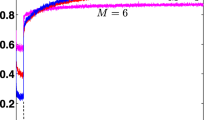Abstract
Synchronizing time between the sensors of wireless sensor network has vital importance. It helps in maintaining a consistent and reliable frame of time across the network. Two clocks are stated to be synchronized when their frequency source runs with equal rate and their offsets are set identical. Basically, due to the manufacturing difference there is slight variation in their clock oscillator which affects the degree of frequency source and accuracy. Therefore this leads to the problem of synchronizing time between the sensor clocks. To attain time synchronization in a network typical contention-based message passing techniques are used. In this paper two-way message passing scheme is utilized. It proposes a statistical tool based on the maximum probability theory for selecting the reference clock offset for time synchronization protocols. It also proposes a subset selection algorithm to support the proposed statistical tool. The results obtained consist of the selection of most probable estimate for clock offset. The proposed algorithm utilizes the two-way message passing scheme for the exchange of timing messages within the network. The proposed algorithm is compared with the existing algorithms for estimation of clock offset. It was observed that the proposed works gives better results in terms of efficiency i.e. 99.8% efficient.










Similar content being viewed by others
References
Arya R, Sharma SC (2014) Energy optimization of energy aware routing protocol and bandwidth assessment for wireless sensor network. Int J Syst Assur Eng Manag. https://doi.org/10.1007/s13198-014-0289-3
Arya R, Sharma SC (2015) Optimization approach for energy minimization and bandwidth estimation of WSN for data centric protocols. Int J Syst Assur Eng Manag, pp 1–10
Bandeira AS et al (2017) Tightness of the maximum likelihood semidefinite relaxation for angular synchronization. Math Program 163(1–2):1–145
Bartosz M, Zwierzykowski P (2012) Survey of simulators for wireless sensor networks. Int J Grid Distrib Comput 5(3):23–50
Elson JE (2003) Time synchronization in wireless sensor networks. In Ph.D. Dissertation, University of California, Los Angeles, pp 64–89
Elson J, Römer K (2003) Wireless sensor networks: a new regime for time synchronization. SIGCOMM Comput Commun 33(1):149–154
Fan R and Lynch N (2004) Gradient clock synchronization. In: Proceedings 23rd annual ACM symposium on principles of distributed computing (PODC), pp 320–327
Gautam GC, Sharma TP et al. (2011) Time synchronization protocol for wireless sensor networks using clustering. In: International conference on recent trends in information technology (ICRTIT), pp 417–422
He J, Cheng P, Chen J, Shi L, Lu R (2014) Time synchronization for random mobile sensor networks. IEEE Trans Veh Technol 63(8):3935–3946
Iutzeler F, Ciblat P, Jakubowicz J (2012) Analysis of max-consensus algorithms in wireless channels. IEEE Trans Signal Process 60(11):6103–6107
Leng M, Wu YC (2010) On clock synchronization algorithms for wireless sensor networks under unknown delay. IEEE Trans Veh Technol 59:182–190
Lenzen C, Locher T, Wattenhofer R (2009) Tight bounds for clock synchronization. In: Proceedings 28rd annual ACM symposium on principles of distributed computing (PODC), pp 46–55
Lenzen C, Sommer P, Wattenhofer R (2009) Optimal clock synchronization in networks. In: Proceedings 7th ACM conference on embedded networked sensor systems (SenSys), pp 225–238
Li Q, Rus D (2006) Global clock synchronization in sensor networks. IEEE Trans Comput 55(2):214–226
Mills DL (1985) Algorithms for synchronizing network clocks. DARPA network working group report RFC-956, Network working group, March 1985
Mills DL (2011) Computer network time synchronization: the network time protocol on earth and in space. CRC Press, Boca Raton, pp 10–466
Ranganathan P, Kendall N (2010) Time synchronization in wireless sensor networks: a survey. Int J UbiComp 1(2):92–102
Ren FY, Lin C, Liu F (2008) Self-correcting time synchronization using reference broadcast in wireless sensor network. IEEE Wirel Commun 15(4):79–85
Serpedin E, Chaudhari Q (2009) Synchronization of wireless sensor networks: parameter estimation, performance benchmarks and protocols. Cambridge University Press, Cambridge, pp 15–52. ISBN 9780521764421
Sichitiu ML, Veerarittiphan C (2003) Simple, accurate time synchronization for wireless sensor networks. IEEE Wirel Commun Netw (WCNC) 2:1266–1273
Singh DP, Goudar RH (2014) Energy efficient clearance routing in WSN. Int J Syst Assur Eng Manag 8(2):1–10
Swain AR, Hansdah RC (2015) A model for the classification and survey of clock synchronization protocols in WSNs. Ad Hoc Netw 27(C):219–241
Tian X, Miao Y, Hu T, Fan B, Pan J, Xu W (2009) Maximum likelihood estimation based on time synchronization algorithm for wireless sensor networks. In: International colloquium on computing, communication, control, and management (CCCM), Sanya, pp 416–420
Ting W, Di G, Chun-yang C, Xiao-ming T, Heng W (2015) Clock synchronization in wireless sensor networks: analysis and design of error precision based on lossy networked control perspective. Math Prob Eng 2015:1–17
Upadhyay D, Banerjee P (2016) An energy efficient proposed framework for time synchronization problem of wireless sensor network. Adv Intell Syst Comput 435:377–385
Upadhyay D, Dubey AK (2017) Statistical tool for clock offset selection in time synchronization protocols of Wireless Sensor Network. In: International Conference on Cloud Computing, Data Science & Engineering(Confluence), pp 397–401
Xing Y, Chen Y, Yi W, Duan C (2015a) Time synchronization for wireless sensor networks using adaptive linear prediction. Int J Distrib Sens Netw 2015:1–9
Xing Y, Chen Y, Sun H, Yi W, Duan C (2015b) Adaptive linear prediction for time synchronization in wireless sensor networks. Int J Distrib Sen Netw 2015(22):1–1
Zhong Z, Chen P, He T (2011) On-demand time synchronization with predictable accuracy. In: Proceedings IEEE conference on computer communications (IEEE INFOCOM), pp 2480–2488
Author information
Authors and Affiliations
Corresponding author
Rights and permissions
About this article
Cite this article
Upadhyay, D., Dubey, A.K. & Santhi Thilagam, P. Time synchronization problem of wireless sensor network using maximum probability theory. Int J Syst Assur Eng Manag 9, 517–524 (2018). https://doi.org/10.1007/s13198-018-0698-9
Received:
Revised:
Published:
Issue Date:
DOI: https://doi.org/10.1007/s13198-018-0698-9




